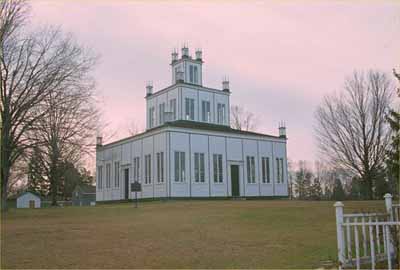Sharon Temple National Historic Site of Canada
Sharon, Ontario

General view
(© Parks Canada Agency/ Agence Parcs Canada, 1991.)
Address :
18974 Leslie Street, Sharon, Ontario
Recognition Statute:
Historic Sites and Monuments Act (R.S.C., 1985, c. H-4)
Designation Date:
1990-02-23
Dates:
-
1825 to 1831
(Construction)
-
1825 to 1889
(Significant)
-
1917 to 1917
(Significant)
Event, Person, Organization:
-
Children of Peace
(Organization)
-
York Pioneer and Historical Society
(Organization)
-
David Willson
(Architect)
-
Ebenezer Doan
(Builder)
Other Name(s):
-
Sharon Temple
(Designation Name)
Research Report Number:
1990-001, 1994-030
Plaque(s)
Existing plaque: on property alongside Leslie Street sidewalk 18974 Leslie Street, Sharon, Ontario
This elegant structure stands as testament to the faith and good works of the Children of Peace. In 1825-1832 master carpenters Ebenezer and John Doan constructed it to the plans of religious leader David Willson who was inspired by Biblical descriptions of Solomon's Temple and the New Jerusalem. The square plan symbolized the sect's egalitarian beliefs and cooperative principles. Once a month and on holidays the Temple was the scene of music-filled ceremonies. Its rescue from demolition in 1918 by the York Pioneer and Historical Society is an early example of historic conservation in Canada.
Description of Historic Place
Sharon Temple National Historic Site of Canada is located north of Toronto, in the village of Sharon. It is an elegant wooden building comprised of three storeys of diminishing size. All four sides of the building are filled with large windows that are candle-lit for special celebrations. The Temple sits in the centre of a large, grassed area, which also contains a collection of other buildings associated with the religious community. The designation refers to the Temple on its lot.
Heritage Value
Sharon Temple was designated a National Historic Site of Canada in 1990 because: of its aesthetic qualities, symbolism and structural design, as an embodiment of the values of he Children of Peace, and as an early example of the conservation of an historic building in Canada.
Its heritage value resides in the quality of its Neo-classical design and pioneer craftsmanship and in its physical manifestation of the beliefs of the Children of Peace who established a co-operative community north of Toronto named Sharon, known at that time as Hope. The temple was built by the members of the community between 1825 and 1831 to the designs of David Willson, the community leader, under the direction of master carpenter Ebenezer Doan. The last service was held in the Temple in 1889. In 1917, it was acquired by the York Pioneer and Historical Society, which started restorations and developed it as an historic site, moving additional buildings to the property over the years.
Sources: Historic Sites and Monuments Board of Canada, Minutes, 1990; Commemorative Integrity Statement.
Character-Defining Elements
The key character-defining elements that contribute to the heritage character of this site include: its isolated setting in a green space; its related collection of other buildings associated with the religious community; its superimposed cubic forms and classically-inspired proportions; the use of traditional, largely wooden construction materials; its open, light-infused interior space with focus on the central Ark; its symmetrical design of four façades, each ground floor facade with a central doorway flanked by large, evenly-spaced, multi-paned windows; the slender, linear quality of its neo-classical detailing, emphasized by the use of contrasting paint colours; the fine craftsmanship; the objects directly related to the Children of the Peace, including the Ark, the original chairs used in the temple, the banners by Richard Coates, the candle holders, and the archival material and musical instruments.